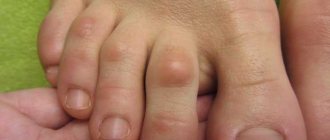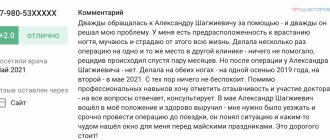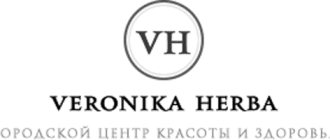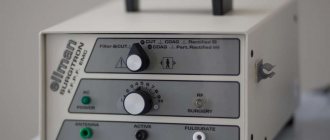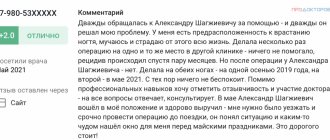There are contraindications. Specialist consultation is required.
Stages of ingrown nails Treatment methods How is the removal procedure performed? Why is onychocryptosis dangerous? Causes of ingrown toenails
Ingrown toenail (Onychocryptosis) is a fairly common disease among both sexes, regardless of age. It is associated with the ingrowth of the nail plate into soft tissue, more often on one side. However, there are cases when the nail grows in on both sides at the same time.
An ingrown toenail usually appears on the big toe, as it is subject to the most pressure when walking.
This disease is accompanied by constant pain, especially when walking and wearing shoes; ulcers, redness, and the growth of excess nail tissue can form. A finger with such a nail usually increases in size and also swells. Either treatment or removal of an ingrown toenail is required.
Stages of ingrown nails
Quite often, it is the big toe that becomes the target of an ingrown toenail. This is due to the physiological structure of a person.
As for the reasons, it could be a genetic predisposition, various nail deformations, hormonal levels, or improper pedicure, hygiene procedures, or fungus.
Depending on the degree of damage to the area of the finger, three stages of the disease are distinguished:
- the formation of redness, pain, as well as slight swelling, and the ingrown nail rather weakly affects the soft tissues;
- the second stage is already accompanied by infection, as well as purulent inflammation;
- The third stage of onychocryptosis not only combines the previous two, but is also accompanied by tissue granulation, and inflammatory processes become chronic, which leads to long-term treatment.
Osokin Anton Vladimirovich
Surgeon/oncologist (mammologist), coloproctologist
“To prevent this disease, you need to carefully care for your nails. You should not cut them too often and too much, or excessively round them. You definitely need to use a nail file to work on the corners of the nail plate. In addition, it is not recommended to wear shoes that are tapered to the front. Fingers and toes must be protected from bruises.”
Symptoms of pathology
How to understand that a nail is ingrown ? The patient develops typical symptoms of the disease:
- Intense pain syndrome. The patient feels severe pain in the nail area, which intensifies when walking or putting on outdoor shoes. The pain is associated with the inflammatory process, and tight shoes aggravate the situation: the space between the toes decreases, and pressure occurs on the ingrown nail plate.
- Redness, swelling, and bright pulsation in the nail area indicate that urgent medical intervention is necessary: the pathology may be complicated by an infectious process.
- Purulent discharge from under the nail plate is a sign of infection at the site of inflammation. Urgent treatment of an ingrown toenail and consultation with a doctor is required.
- Formation of small ulcers. Ulcers form if the ingrown toenail has been injured or subjected to mechanical impact (intense blow or severe bruise).
- The growth of pathological tissue around the nail - the patient should be alert to this symptom, because such tissue in appearance resembles raw meat.
- Violation of the normal shape of the plate. The nail may decrease in length, its thickness increases, and the soft tissues become rougher - these signs indicate that the disease has become chronic.
Treatment can be carried out therapeutically, without surgery, if you consult a doctor in time. Medical doctors will help you cope with onychocryptosis quickly and painlessly!
Treatment of ingrown toenails
At the first stage, an ingrown toenail can be corrected without surgery. This consists of straightening the shape of the nail, giving it the correct shape using special plastic or cotton inserts. It is necessary to get rid of narrow shoes and not overload yourself physically. Additionally, your doctor may prescribe all kinds of procedures and medications.
This treatment is quite long and may be completely ineffective. In addition, ingrown nails begin from its base, and not, as is commonly believed, from the corner. Therefore, part of the nail plate is simply not visible.
Therefore, in some cases, surgical treatment is used.
Hardware pedicure
This method is also called mechanical. The procedure requires a special device - a milling cutter, which is used for cosmetic manicure. It has a rotating element and replaceable abrasive attachments. It is important to know that nail removal is not a cosmetic procedure, and a doctor, not a pedicurist, should work with a milling cutter.
- diseases associated with poor blood clotting;
- HIV infection;
- capillary permeability;
- diseases of an inflammatory or infectious nature.
After consultation, foci of infection are identified and removal begins. This is a rather lengthy process: one finger can take half an hour. During treatment, the area heats up from friction, but in general, the procedure is painless. It goes like this:
- the treatment area and the device itself are disinfected;
- A softening compound is applied to the nail, which makes filing easier;
- the doctor sequentially removes the stratum corneum, getting to the root of the infection;
- antifungal and antimicrobial agents are applied.
The big advantage of using hardware is that it saves time: cutting is done once. No anesthesia is required, which means no chemicals. Compared to surgical removal, this is a gentler method and rarely causes bleeding. Since there is no open wound, rehabilitation takes less time and there is no discomfort.
The process of surgery to remove an ingrown toenail
Surgical method
Local anesthesia
Operation time: up to 30 minutes
Hospital recovery - not required
Cost of the operation: from 3,050 rubles.
After examining the patient, the surgeon may prescribe a general blood test to assess the severity of the inflammatory process in the body. You may also be referred for an x-ray if osteomyelitis is suspected.
There are several options for removing an ingrown toenail: complete removal of the nail, plastic surgery of the nail bed and nail fold, and also using radio wave surgery.
At SM-Clinic, operations are performed to remove ingrown toenails using radio waves. There is almost no bleeding, healing occurs within two weeks. The advantages of the methods are that they provide rapid healing, do not cause tissue destruction, and are characterized by the absence of scars and purulent complications after surgery.
Radio wave removal of ingrown toenails is performed under local anesthesia.
Our surgery center features:
- more than 15 highly qualified surgeons;
- the latest equipment;
- comfortable room;
- 24-hour surveillance;
- recovery in 1 day.
If it is not possible to eliminate the deformity of an ingrown toenail using plates, staples and springs, they move from conservative correction of onychocryptosis to surgical treatment. Instead of traumatic classical operations, preference is given to modern minimally invasive surgical methods.
Conservative treatment methods
Non-surgical treatment is carried out only in the absence of purulent inflammation. Two methods can be used for this:
- tamponing and the use of local medications: the doctor will prescribe antiseptics that eliminate inflammation and stop the growth of granulation tissue;
- orthonyxia, or the use of correction devices: a specialist installs special staples and plates that allow you to direct the growth of the nail plate in the right direction and correct the condition. This treatment may take several months.
Despite the fact that conservative methods in some cases allow one to avoid surgery, they are not without a number of disadvantages. They can be resorted to only in case of uncomplicated inflammatory process. When there is suppuration of tissues and granulations, it is not advisable to use them. The course of therapy will take quite a long time, from several weeks to several months. Correctors are an expensive tool, and it is important to visit a doctor regularly to evaluate the condition. The specialist will not be able to guarantee the effectiveness; the likelihood of the need for intervention still remains.
This decision is advisable only in the absence of pronounced painful symptoms or high risks of infection. It is suitable for patients who are contraindicated for surgical interventions.
Radio wave methods for correcting ingrown toenails
An ingrown toenail is removed on an outpatient basis. As a result of this exposure, the tissues are disinfected. After the manipulation there are no stitches and no scars remain. The tissues heal quickly, and over time a young, healthy nail grows.
The procedure is performed either as planned by appointment, or on the day of treatment, after examination and consultation. In the device menu, the doctor sets individual settings and brings the handpiece to the affected area.
After superficial anesthesia, the ingrown edge of the nail and granulations - growths of soft tissue of the finger in the periungual area - are removed using a non-contact method. Then the growth zone of the nail is treated. Radio wave treatment of onychocryptosis is carried out in a similar way.
How to care for your nail after removal
Regardless of the removal method, it is imperative to take care of the remaining wound. This is necessary to prevent inflammatory processes and relapse of infection. Immediately after removal, the surface is disinfected again, healing and antifungal ointments are applied under a gauze bandage. Then treatment is prescribed for both external use and oral administration.
- do the dressing every day until the wound heals;
- keep the dressing sterile and dry. If it gets wet or dirty, replace it immediately;
- in the first days, strict bed rest is prescribed;
- do not put weight on the affected leg while walking;
- During rehabilitation, try not to wear shoes, wear clean socks made of well-ventilated, natural fabric.
If swelling or suppuration appears on the bed, you should urgently consult your doctor. A healthy nail does not grow as quickly as we would like. After two to three weeks, the wound will heal, and you can loosen the strict supervision a little and get prosthetics. On average, a nail grows 3 mm per month. Due to the physiological characteristics of the body, this process occurs more slowly on the legs than on the arms. Thus, the plate will grow back completely no earlier than in six months.
Why is an ingrown toenail dangerous?
An ingrown toenail itself causes pain and discomfort when walking. In addition, more serious complications may subsequently develop:
- finger abscess;
- osteomyelitis;
- gangrene.
Increased risk for people with diabetes mellitus, obliterating endarteritis, varicose veins, atherosclerosis of the vessels of the lower extremities, and those with impaired immunity. In such cases, the infection can spread to the foot and lower leg - then phlegmon develops. The result can be gangrene and amputation.
Causes of ingrown toenails
A toenail may grow ingrown for the following reasons:
- wearing tight shoes;
- improper pedicure with cutting off the corners of the nail;
- strong deviation of the direction of the thumb inward or outward with transverse flatfoot;
- wide fingers with pronounced nail folds, convex nails, the lateral edges of which sharply bend almost at a right angle;
- large static or dynamic loads, excess body weight.
Prices
Price (rub.)In installments* (rub.)Operations for ingrown toenails, matrixectomy (1 zone) Cat. I. complexity from 3050—Operations for ingrown toenails, matrixectomy (1 zone) Cat. II. complexity from 4050—Operations for ingrown toenails, matrixectomy (1 zone) Cat. III. complexityfrom 5900—* You can read more about the conditions here - Treatment on credit or in installments
The cost is preliminary. The exact cost of the operation can only be determined by a surgeon during a free consultation.
Reviews
IVAN 03.03.2017 11:39
Attending physician Sergey Viktorovich Khokhlov
I would like to thank the surgeon Sergei Viktorovich Khokhlov! I was dealing with a problem, an ingrown toenail, this problem has been tormenting me for a very long time, in the hospital they simply cut and trimmed the nail, but after two months it appeared again! I decided to try to do it with a laser, and turned to the SM-Clinic network, where they did everything for me at the highest level, they numbed my finger well, I didn’t feel anything! done quickly! everything is good, but the price tag is of course too high!!
About the clinic
The Medical Advisor Clinic is highly professional in diagnosis, anti-age therapy and patient care.
Our staff unites reputable specialists: urologists-andrologists, gynecologists, cardiologists, endocrinologists, cosmetologists. The clinic’s doctors, who have specialized training in the field of anti-age medicine, are proficient in the most advanced methods of diagnosing and treating age-related problems. The clinic's equipment allows for accurate diagnosis and treatment.
“Medical Advisor” is the first European-level specialized clinic in Yekaterinburg, specializing in the entire range of anti-age therapy.
We build relationships with patients on the basis of confidentiality. The organization of the internal space of the clinic allows for a private visit and allows you to feel as comfortable and free as possible. Prices as of January 11, 2022
